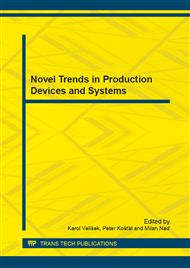p.3
p.9
p.15
p.21
p.27
p.35
p.42
p.49
p.55
The Methodology of Development of the Manufacturing Information Acquisition System (MIAS) for Production Management
Abstract:
The acquisition of data on the state of the production process is essential in the management of a company. The ERP system, as well as company management, should be continuously supplied with up-to-date information about the state of the production system, but in many cases there is a gap between the business and manufacturing layers of a company. Data on the state of production orders, machines, materials and human resources have to be automatically acquired, transmitted, archived, pre-processed and converted to a form compatible with business layer systems. There is a need for the development of methodology, describing methods of data acquisition and pre-processing directly from the shop floor. The methodology should be universal, covering the needs of different types of technological processes (discrete, continuous, batch), branches of industry and levels of production automation, etc. This paper presents the methodology of the development of Manufacturing Information Acquisition System (MIAS) covering needs for automated data acquisition, archiving and pre-processing systems, able to provide on-line production processes information for various clients. MIAS can be used as a link between data sources, MES/ERP systems and company management. Furthermore, it can be used as a stand-alone management information tool.
Info:
Periodical:
Pages:
27-32
Citation:
Online since:
January 2014
Authors:
Keywords:
Price:
Сopyright:
© 2014 Trans Tech Publications Ltd. All Rights Reserved
Share:
Citation:


